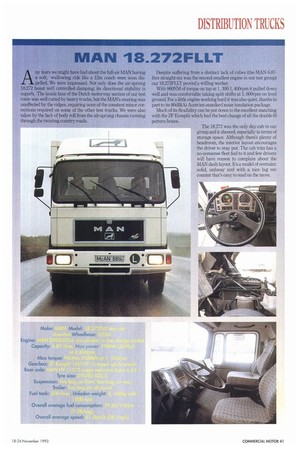MAN 18.272FLLT
Page 43

If you've noticed an error in this article please click here to report it so we can fix it.
Any fears we might have had about the full-air MAN having a soft, wallowing ride like a 12m coach were soon dispelled, We were impressed. Not only does the air-sprung 18.272 boast well controlled damping; its directional stability is superb. The inside lane of the Dutch motorway section of our test route was well rutted by heavy trucks, but the MAN's steering was unaffected by the ridges, requiring none of the constant minor corrections required on some of the other test trucks. We were also taken by the lack of body roll from the air-sprung chassis running through the twisting country roads. Despite suffering from a distinct lack of cubes (the MAN 6.87litre straight-six was the second smallest engine in our test group) our 18.272FLIT proved a willingworker.
With 960NM of torque on tap at 1, 300-1, 400rpm it pulled down well and was comfortable taking split shifts at 1, 600rpm on level ground. For a little engine working hard it was also quiet, thanks in part to its 80d)3(A) Austrian-standard noise insulation package.
Much of its flexibility can be put down to the excellent matching with the 7 Ecosplit which had the best change of all the double-H pattern boxes,
:The 18.272 was the only clay-cab in our group and it showed, especially in terms of storage space. Although there's plenty of headroom, the interior layout encourages the driver to stay put. The cab trim has a no-nonsense fleet feel to it and few drivers _, • will have reason to complain about the MAN dash layout. Ws a model of restraint: solid, unfussy and with a nice big rev counter that's easy to read on the move.




















































































































